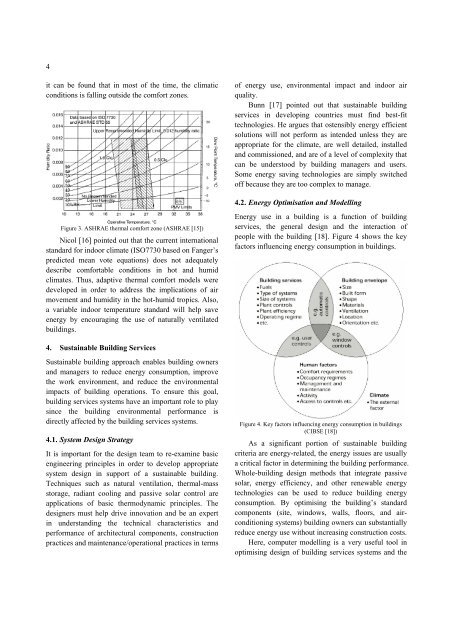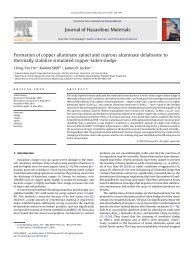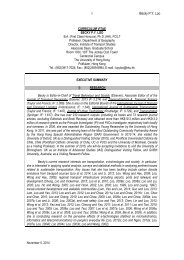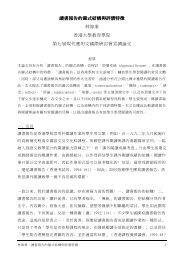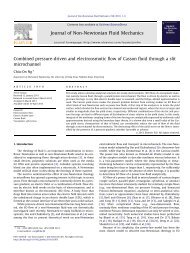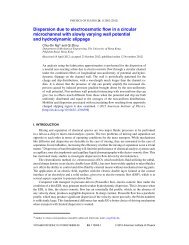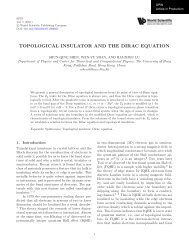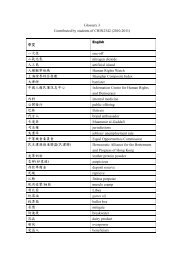sustainable building technologies for hot and humid climates
sustainable building technologies for hot and humid climates
sustainable building technologies for hot and humid climates
Create successful ePaper yourself
Turn your PDF publications into a flip-book with our unique Google optimized e-Paper software.
4<br />
it can be found that in most of the time, the climatic<br />
conditions is falling outside the com<strong>for</strong>t zones.<br />
of energy use, environmental impact <strong>and</strong> indoor air<br />
quality.<br />
Bunn [17] pointed out that <strong>sustainable</strong> <strong>building</strong><br />
services in developing countries must find best-fit<br />
<strong>technologies</strong>. He argues that ostensibly energy efficient<br />
solutions will not per<strong>for</strong>m as intended unless they are<br />
appropriate <strong>for</strong> the climate, are well detailed, installed<br />
<strong>and</strong> commissioned, <strong>and</strong> are of a level of complexity that<br />
can be understood by <strong>building</strong> managers <strong>and</strong> users.<br />
Some energy saving <strong>technologies</strong> are simply switched<br />
off because they are too complex to manage.<br />
4.2. Energy Optimisation <strong>and</strong> Modelling<br />
Figure 3. ASHRAE thermal com<strong>for</strong>t zone (ASHRAE [15])<br />
Nicol [16] pointed out that the current international<br />
st<strong>and</strong>ard <strong>for</strong> indoor climate (ISO7730 based on Fanger’s<br />
predicted mean vote equations) does not adequately<br />
describe com<strong>for</strong>table conditions in <strong>hot</strong> <strong>and</strong> <strong>humid</strong><br />
<strong>climates</strong>. Thus, adaptive thermal com<strong>for</strong>t models were<br />
developed in order to address the implications of air<br />
movement <strong>and</strong> <strong>humid</strong>ity in the <strong>hot</strong>-<strong>humid</strong> tropics. Also,<br />
a variable indoor temperature st<strong>and</strong>ard will help save<br />
energy by encouraging the use of naturally ventilated<br />
<strong>building</strong>s.<br />
Energy use in a <strong>building</strong> is a function of <strong>building</strong><br />
services, the general design <strong>and</strong> the interaction of<br />
people with the <strong>building</strong> [18]. Figure 4 shows the key<br />
factors influencing energy consumption in <strong>building</strong>s.<br />
4. Sustainable Building Services<br />
Sustainable <strong>building</strong> approach enables <strong>building</strong> owners<br />
<strong>and</strong> managers to reduce energy consumption, improve<br />
the work environment, <strong>and</strong> reduce the environmental<br />
impacts of <strong>building</strong> operations. To ensure this goal,<br />
<strong>building</strong> services systems have an important role to play<br />
since the <strong>building</strong> environmental per<strong>for</strong>mance is<br />
directly affected by the <strong>building</strong> services systems.<br />
4.1. System Design Strategy<br />
It is important <strong>for</strong> the design team to re-examine basic<br />
engineering principles in order to develop appropriate<br />
system design in support of a <strong>sustainable</strong> <strong>building</strong>.<br />
Techniques such as natural ventilation, thermal-mass<br />
storage, radiant cooling <strong>and</strong> passive solar control are<br />
applications of basic thermodynamic principles. The<br />
designers must help drive innovation <strong>and</strong> be an expert<br />
in underst<strong>and</strong>ing the technical characteristics <strong>and</strong><br />
per<strong>for</strong>mance of architectural components, construction<br />
practices <strong>and</strong> maintenance/operational practices in terms<br />
Figure 4. Key factors influencing energy consumption in <strong>building</strong>s<br />
(CIBSE [18])<br />
As a significant portion of <strong>sustainable</strong> <strong>building</strong><br />
criteria are energy-related, the energy issues are usually<br />
a critical factor in determining the <strong>building</strong> per<strong>for</strong>mance.<br />
Whole-<strong>building</strong> design methods that integrate passive<br />
solar, energy efficiency, <strong>and</strong> other renewable energy<br />
<strong>technologies</strong> can be used to reduce <strong>building</strong> energy<br />
consumption. By optimising the <strong>building</strong>’s st<strong>and</strong>ard<br />
components (site, windows, walls, floors, <strong>and</strong> airconditioning<br />
systems) <strong>building</strong> owners can substantially<br />
reduce energy use without increasing construction costs.<br />
Here, computer modelling is a very useful tool in<br />
optimising design of <strong>building</strong> services systems <strong>and</strong> the


